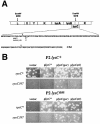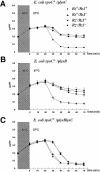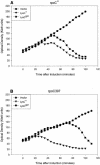P2 growth restriction on an rpoC mutant is suppressed by alleles of the Rz1 homolog lysC
- PMID: 15231796
- PMCID: PMC438596
- DOI: 10.1128/JB.186.14.4628-4637.2004
P2 growth restriction on an rpoC mutant is suppressed by alleles of the Rz1 homolog lysC
Abstract
Escherichia coli strain 397c carries a temperature-sensitive mutation, rpoC397, that removes the last 50 amino acids of the RNA polymerase beta' subunit and is nonpermissive for plating of bacteriophage P2. P2 gor mutants productively infect 397c and define a new gene, lysC, encoded by a reading frame that extensively overlaps the P2 lysis accessory gene, lysB. The unusual location of lysC with respect to lysB is reminiscent of the Rz/Rz1 lysis gene pair of phage lambda. Indeed, coexpression of lysB and lysC complemented the growth defect of lambda Rz/Rz1 null mutants, indicating that the LysB/C pair is similar to Rz/Rz1 in both gene arrangement and function. Cells carrying the rpoC397 mutation exhibited an early onset of P2-induced lysis, which was suppressed by the gor mutation in lysC. We propose that changes in host gene expression resulting from the rpoC397 mutation result in changes in the composition of the bacterial cell wall, making the cell more susceptible to P2-mediated lysis and preventing accumulation of progeny phage sufficient for plaque formation.
Copyright 2004 American Society for Microbiology
Figures





Similar articles
-
Escherichia coli rpoC397 encodes a temperature-sensitive C-terminal frameshift in the beta' subunit of RNA polymerase that blocks growth of bacteriophage P2.J Bacteriol. 1996 Dec;178(23):6991-3. doi: 10.1128/jb.178.23.6991-6993.1996. J Bacteriol. 1996. PMID: 8955324 Free PMC article.
-
Functions involved in bacteriophage P2-induced host cell lysis and identification of a new tail gene.J Bacteriol. 1994 Aug;176(16):4974-84. doi: 10.1128/jb.176.16.4974-4984.1994. J Bacteriol. 1994. PMID: 8051010 Free PMC article.
-
Identification and functional analysis of the Rz/Rz1-like accessory lysis genes in the membrane-containing bacteriophage PRD1.Mol Microbiol. 2008 Apr;68(2):492-503. doi: 10.1111/j.1365-2958.2008.06165.x. Mol Microbiol. 2008. PMID: 18366440
-
Bacteriophage lambda lysis gene product modified and inserted into Escherichia coli outer membrane: Rz1 lipoprotein.Microb Drug Resist. 1996 Spring;2(1):147-53. doi: 10.1089/mdr.1996.2.147. Microb Drug Resist. 1996. PMID: 9158738 Review.
-
Activation of P2 late transcription by P2 Ogr protein requires a discrete contact site on the C terminus of the alpha subunit of Escherichia coli RNA polymerase.J Mol Biol. 1997 Nov 21;274(1):1-7. doi: 10.1006/jmbi.1997.1390. J Mol Biol. 1997. PMID: 9398509 Review.
Cited by
-
Bacteriophage P2.Bacteriophage. 2016 Feb 18;6(1):e1145782. doi: 10.1080/21597081.2016.1145782. eCollection 2016 Jan-Mar. Bacteriophage. 2016. PMID: 27144088 Free PMC article. Review.
-
The Caulobacter crescentus phage phiCbK: genomics of a canonical phage.BMC Genomics. 2012 Oct 10;13:542. doi: 10.1186/1471-2164-13-542. BMC Genomics. 2012. PMID: 23050599 Free PMC article.
-
Genomic analysis and relatedness of P2-like phages of the Burkholderia cepacia complex.BMC Genomics. 2010 Oct 25;11:599. doi: 10.1186/1471-2164-11-599. BMC Genomics. 2010. PMID: 20973964 Free PMC article.
-
The final step in the phage infection cycle: the Rz and Rz1 lysis proteins link the inner and outer membranes.Mol Microbiol. 2008 Oct;70(2):341-51. doi: 10.1111/j.1365-2958.2008.06408.x. Epub 2008 Aug 18. Mol Microbiol. 2008. PMID: 18713319 Free PMC article.
-
The Ms6 Mycolyl-Arabinogalactan Esterase LysB is Essential for an Efficient Mycobacteriophage-Induced Lysis.Viruses. 2017 Nov 17;9(11):343. doi: 10.3390/v9110343. Viruses. 2017. PMID: 29149017 Free PMC article.
References
-
- Baldwin, R. L., P. Barrand, A. Fritsch, D. A. Goldthwait, and F. Jacob. 1966. Cohesive sites on the deoxyribonucleic acids from several temperate coliphages. J. Mol. Biol. 17:343-357. - PubMed
-
- Bartel, P. L., J. A. Roecklein, D. SenGupta, and S. Fields. 1996. A protein linkage map of Escherichia coli bacteriophage T7. Nat. Genet. 12:72-77. - PubMed
-
- Bertani, L. E. 1957. The effect of the inhibition of protein synthesis on the establishment of lysogeny. Virology 4:53-71. - PubMed
Publication types
MeSH terms
Substances
Grants and funding
LinkOut - more resources
Full Text Sources

